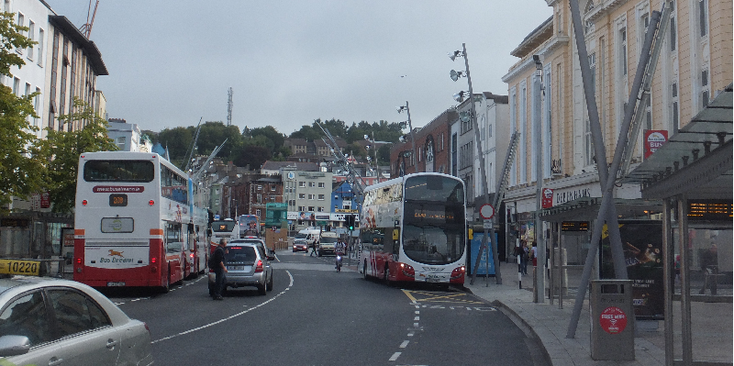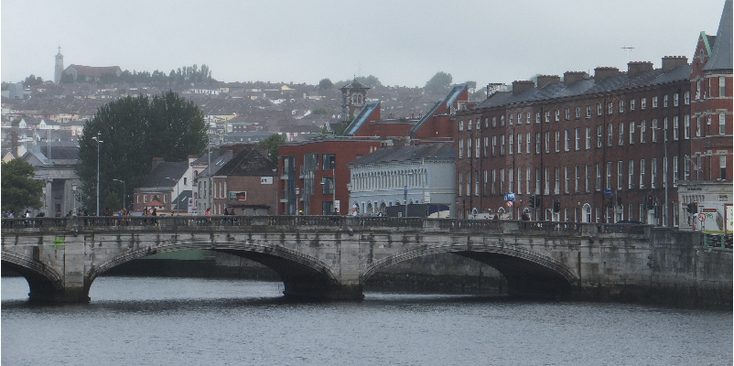Cork
Places of Interest - Ireland


introduction
Cork (Irish: Corcaigh means a marshland) is the second largest city in the Republic of Ireland, and is situated almost on the south coast of the island. The River Lee runs right through the city and the biggest chunk of Cork lies on an island in the mouth of this river. The port is one of the largest natural ports in the world.
Cork has a reputation for independence from the time of invasions by the Vikings to the Irish War for Independence, and therefore bears the nickname Rebel Cork. The city is known for its many good restaurants, its cozy atmospheric center of canals and rivers and its location near the beautiful west coast of Ireland. The city is the seat of the Roman Catholic diocese Cork and Ross. The city center architecture can measure herself with the architecture with Dublin and Belfast.
highlights

The inner city:
The main and shopping street St. Patrick's Street has had a major turnaround that was completed in 2004. Grand Parade, another street in the city center, is a wide street with trees and connects Patrick Street with South Mall. South Mall is located on the other side of the island in the middle of Lee, which forms the center.
Many financial institutions and offices are located in this street. The city once had a city wall and a network of canals, but there are only parts left of it. Cork has two major galleries, known as the Crawford Municipal Art Gallery and the Lewis Glucksman Gallery. You can also visit the popular Cork Public Museum.
The city also has two major cathedrals: St. Mary's Cathedral the cathedral of the diocese of the Church of Ireland and St. Finbar's Cathedral, which is the seat of the Roman Catholic diocese Cork and Ross. The modern Cork Opera House is one of the few of its kind in Ireland. The old city prison (Cork City Gaol) is another kind of attraction; the prison was closed in 1923 and was used as a radio station four years later.
The museum inside mainly shows the hardness and barbarity of prison life around the last century. Finally, you can visit the Shandon district on the north side of the city center. In addition to the beautiful views, there are plenty of galleries, local shops in narrow streets and around little squares. You have the St. Anne's church, the world's largest buttercup market and small local traditional Irish houses.
Other sights:
- The English market.

history

Cork is an old city, with city rights dating back to the thirteenth century. There is evidence of a monastery founded by Saint Finbar from the year 1172. The city has been rebuilt over the centuries after attacks of, among others, Vikings and Norwegians. In the 12th century, the city became the most important of the region.
In 1185 Cork came under English administration. In the centuries the city became Irish and then English many times. It survived the attacks of Cromwell's army but was taken by Willem van Oranje's troops. The city continued to grow in the 18th century by trade (export) in butter, beer and whiskey. A century later, famine - hundreds of thousands left the city and district by means of emigrating, especially tot he United States.
During the Irish War for Independence in 1920, the city was largely destroyed by a fire started by the British Army; the infamous burning of Cork. The English rulers were hard for the people in Cork and the city itself - the town hall was set in flames, but also the public library and St. Patrick's church. During the short Irish Civil War (1922-1923) thereafter, the city was occupied by Republican troops for some time.

tips & advice (2015)

Cork Airport International Airport is the second airport of the Republic and processed around 2.43 million passengers in 2010. The city of Cork was once a city with a lot of rail traffic. The Kent station is now the only station and is located at the edge of the city center, where every hour an intercity train goes to Dublin.
There are also local trains to Cobh, which is further down the coast, and to Midleton and Mallow. There is a bus station in the center of town near Parnell Place. From here you can travel to most of the cities and places in Ireland.
Cork airport - Cork: bus 226 (A) runs from Kinsdale to Cork and vice versa via the airport. It takes about half an hour and in the evening the bus only runs 1x per hour. Cost 5,50 euro.
Cork - Kinsdale: From the main (central) bus station in Cork, buses (I believe about 15x a day) travel buses (226) from Cork to Kinsdale. The ride takes about an hour and a single ticket costs 9.90 euros while a day trip (return) costs 12.50 euros. A return without fixed enddate costs 15.10 euros.

-
Name : Sheila's hostel
Address : 4 Belgrave Pl. / Wellington Road
Price : 15 euro (dormitory)
Phone nr. : 021 450 5562
Website : www.sheilashostel.ie
Content:
This large hostel is located on the north side of the city center on a small square. The building is old and made from wood – a noisy place where everything cracks and makes a lot of noise. Breakfast is served in the lobby (3 euros) and everything is quite professional.
There is WIFI and you can book tours. A lot of young people come here and it's busy place, very popular. The beds and rooms are old-fashioned - no own lamp, no curtain, no shelf to put your stuff on and no racks for bags. The rooms are small and packed.

see also:
LANDEN:
EUROPA:
Albanië * België * Bosnië-Herzegovina * Bulgarije * Denemarken * Duitsland * Engeland * Estland * Finland * Frankrijk * Griekenland * Hongarije * (Noord) Ierland * Italië * Kosovo * Kroatië * Letland * Litouwen * Luxemburg * Macedonië * Malta * Montenegro * NEDERLAND * Oekraïne * Oostenrijk * Polen * Portugal * Roemenië * Rusland * Schotland * Servië * Slovenië * Slowakije * Spanje * Tsjechië * Turkije * Zweden
NOORD EN CENTRAAL-AMERIKA:
Chili * Costa Rica * Cuba * Guatemala * Mexico * Nicaragua * Panama * Verenigde Staten
ZUID-AMERIKA:
Argentinië * Bolivia * Brazilië * Colombia * Ecuador * Peru
AFRIKA:
Botswana * Burkina Faso * Egypte * Ethiopië * Ghana * Kenia * Mali * Marokko * Namibië * Oeganda * Senegal * Tanzania * Tunesië * Zuid-Afrika
MIDDEN-OOSTEN:
Iran * Israël * Jordanië * V.A.E.
AZIE:
Armenië * Cambodja * China * Filipijnen * Georgië * India * Indonesië * Japan * Kirgizië * Laos * Maleisië * Mongolië * Myanmar * Nepal * Oezbekistan * Singapore * Sri Lanka * Thailand * Vietnam
OCEANIE:
Voor meer reisfoto's kijk op www.instagram.com/cheapskatetravel.nl:
© Cheapskatetravel.nl; 2018 (all rights reserved)


